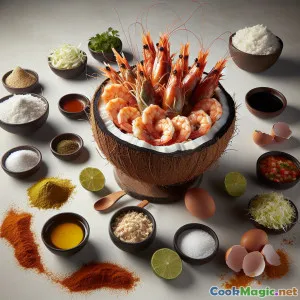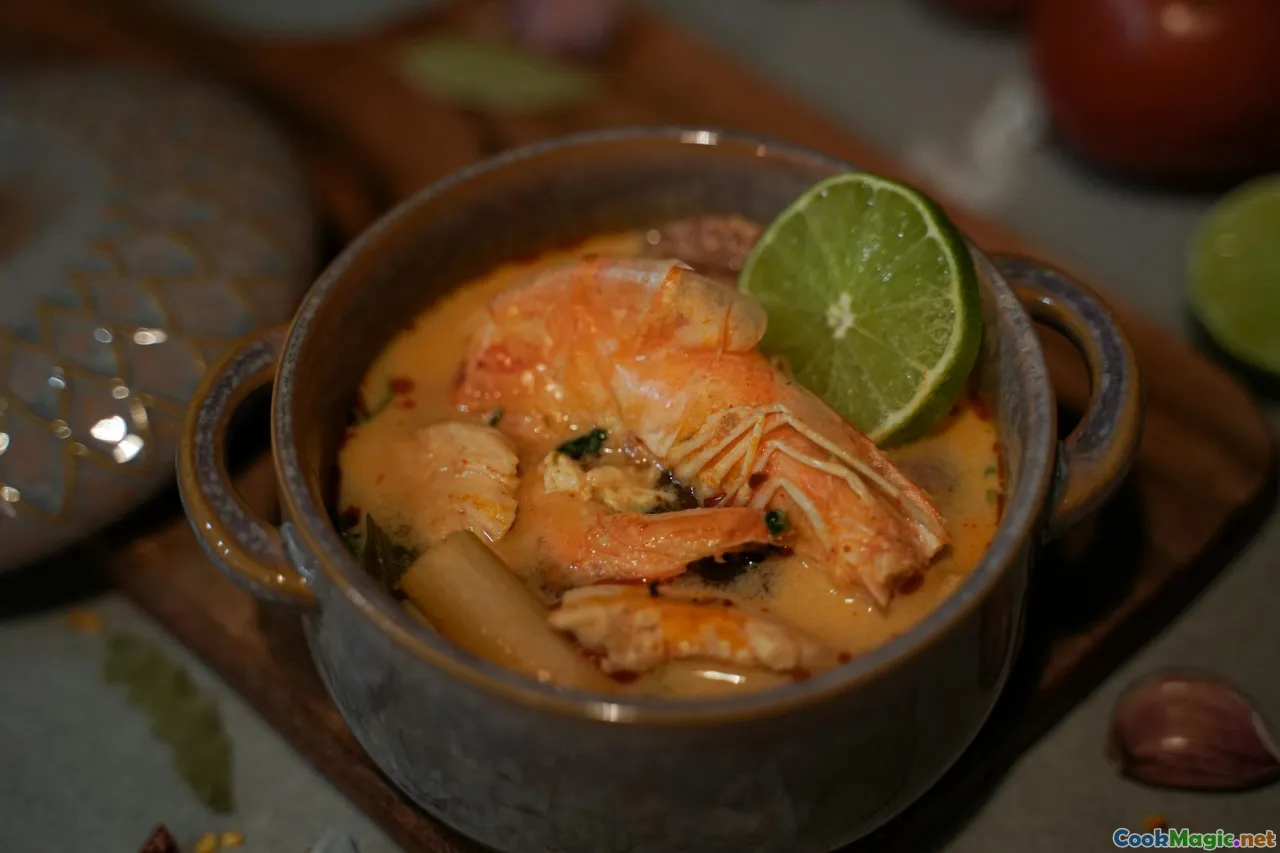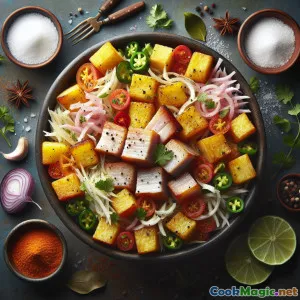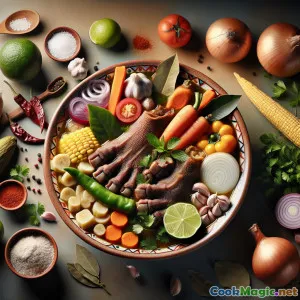
Altın Salvador Usulü Hindistan Cevizli Karides
(Golden Salvadoran Coconut Crusted Shrimp)
(0 Yorumlar)0
1,116
Temmuz 17, 2025
Bir Sorun Bildir
Malzemeler
-
500 grams Büyük karides, soyulmuş ve deveined
(En iyi dokuyu elde etmek için taze veya çözülmüş karides kullanın.)
-
110 grams Şekersiz rendelenmiş hindistancevizi
(Altın renkli çıtır bir kabuk sağlayın)
-
60 grams Un
(İlk una bulama işlemi için)
-
2 large Yumurta
(Çırpılmış, bağlamak için)
-
1.5 tbsp Mısır nişastası
(Kıtır bir doku ekler)
-
1.5 tsp Deniz tuzu
(Ya da damak zevkine göre)
-
1 tsp Karabiber
(Mümkünse taze kırılmış karabiber.)
-
0.5 tsp Paprika
(İnce bir ısı ekler)
-
0.5 tsp Sarımsak tozu
(Kaplama için umami)
-
1 tsp Misket limon kabuğu
(Parlaklık katıyor)
-
400 ml Bitkisel yağ
(Kızartma için (miktar kızartma derinliğine bağlıdır))
-
120 grams Curtido (Salvador usulü lahana salatası)
(Servis için, isteğe bağlı ama geleneksel)
-
120 ml Salvadoran salsa roja
(Veya başka bir acı dip sosu)
(En iyi dokuyu elde etmek için taze veya çözülmüş karides kullanın.)
(Altın renkli çıtır bir kabuk sağlayın)
(İlk una bulama işlemi için)
(Çırpılmış, bağlamak için)
(Kıtır bir doku ekler)
(Ya da damak zevkine göre)
(Mümkünse taze kırılmış karabiber.)
(İnce bir ısı ekler)
(Kaplama için umami)
(Parlaklık katıyor)
(Kızartma için (miktar kızartma derinliğine bağlıdır))
(Servis için, isteğe bağlı ama geleneksel)
(Veya başka bir acı dip sosu)
Besin Değerleri
- Porsiyon: 4
- Porsiyon Boyutu: 1 tabak (250g)
- Calories: 550 kcal
- Carbohydrates: 41 g
- Protein: 29 g
- Fat: 32 g
- Fiber: 5 g
- Sugar: 6 g
- Sodium: 795 mg
- Cholesterol: 215 mg
- Calcium: 125 mg
- Iron: 2.7 mg
Talimatlar
-
1 - Karideslerin hazırlanması:
Karidesleri kağıt havluyla kurulayın. Bir kaseye alın ve 0,5 çay kaşığı deniz tuzu, karabiber ve lime kabuğu rendesiyle tatlandırın (kullanıyorsanız). İyice karıştırarak her tarafını eşit şekilde kaplayın.
-
2 - Paneleme istasyonlarını hazırlayın:
Üç kase hazırlayın: birinde mısır nişastası ile karıştırılmış un, diğerinde çırpılmış yumurta, üçüncüsünde de paprika ve sarımsak tozu ile karıştırılmış rendelenmiş hindistancevizi.
-
3 - Karidesleri kapla:
Baharatlı karidesi önce un ve mısır nişastası karışımına bulayın, fazla unu silkeleyin, sonra yumurtaya batırın ve en sonunda hindistancevizi karışımına iyice yapıştırın.
-
4 - Yağı ısıtın:
Geniş ve derin bir tavada, bitkisel yağı orta-yüksek ateşte 175°C (350°F) ulaşana kadar ısıtın.
-
5 - Kızarmış karides:
Karidesleri parti parti kızartın, bir kez çevirerek, çıtır ve altın rengini alana kadar (parti başına 2–3 dakika). Kağıt havlular üzerinde süzün ve bir tutam deniz tuzu serpin.
-
6 - Servis yapmak:
Daldırma için yanında curtido ve salsa roja ile hemen bir tabakta servis edin. Sıcak ve çıtırken tadını çıkarın.
Karidesleri kağıt havluyla kurulayın. Bir kaseye alın ve 0,5 çay kaşığı deniz tuzu, karabiber ve lime kabuğu rendesiyle tatlandırın (kullanıyorsanız). İyice karıştırarak her tarafını eşit şekilde kaplayın.
Üç kase hazırlayın: birinde mısır nişastası ile karıştırılmış un, diğerinde çırpılmış yumurta, üçüncüsünde de paprika ve sarımsak tozu ile karıştırılmış rendelenmiş hindistancevizi.
Baharatlı karidesi önce un ve mısır nişastası karışımına bulayın, fazla unu silkeleyin, sonra yumurtaya batırın ve en sonunda hindistancevizi karışımına iyice yapıştırın.
Geniş ve derin bir tavada, bitkisel yağı orta-yüksek ateşte 175°C (350°F) ulaşana kadar ısıtın.
Karidesleri parti parti kızartın, bir kez çevirerek, çıtır ve altın rengini alana kadar (parti başına 2–3 dakika). Kağıt havlular üzerinde süzün ve bir tutam deniz tuzu serpin.
Daldırma için yanında curtido ve salsa roja ile hemen bir tabakta servis edin. Sıcak ve çıtırken tadını çıkarın.
Altın Salvador Usulü Hindistan Cevizli Karides :Hakkında Daha Fazlası
Camarones Encostrados en Coco Salvadoreño
Camarones Encostrados en Coco Salvadoreño—or Salvadoran Coconut-Crusted Shrimp—embodies the beautiful cross-pollination at the heart of El Salvador’s culinary heritage. In coastal towns like La Libertad and pristine beaches that line the Pacific, seafood isn't merely food—it’s a way of life. And the coconut palm, ever-present and beloved in El Salvador’s humid zones, makes an ingenious match for the sweet brininess of shrimp. This dish, although inspired by universal coastal appetites, is altogether Salvadoran in its playful use of flavors and its signature accompaniments of spicy curtido and lively salsa roja.
Brief History, Influence & Cultural Significance
Although coconut shrimp dishes exist throughout the world—as street food in Southeast Asia and as appetizers in Caribbean resorts—it’s their Central American cousin that adds that special warm essence emblematic of El Salvador. Salvadoran cookery is resourceful and fearless with bright flavors and texture. Here, instead of battering and deep-frying shrimp in the American style, we dip in coconut threads to enhance texture, aroma, and that irresistible crunch synonymous with Salvadoran fried foods. Curtido, a lightly fermented spicy slaw, brings brightness that evokes pupusería stalls in San Salvador, while traditional salsa roja amplifies the dish’s punch.
Camarones Encostrados en Coco offers Salvadorans a touch of celebration. Reserved for parties by the sea or special Sunday feasts, coconut shrimp draws families together for communal frying and lively conversation. By including house-made curtido and fresh salsas, this dish nods to the foundational garnishes that cradle so many Salvadoran plates, sewing together color, freshness, acid, and spice.
Tips, Secrets & Notes
- Shrimp Size: Opt for large, firm shrimp, preferably wild-caught for peak sweetness. Thorough drying before dredging is key to ensuring the coconut clings and crisps up—do not skip this opening step!
- Coconut Craft: Use unsweetened shredded coconut. Sweetened can caramelize too fast and burn. For a more dramatic crunch, pulse it briefly in the food processor for uniform bits.
- Extra Crispy Edge: Adding a touch of cornstarch to your flour amplifies crunch and gives the shrimp that appetizing golden shell after just a couple of minutes in hot oil.
- Temperature Maintenance: Fry in batches; overcrowding lowers oil temp resulting in greasy, less crisp shrimp. Always let your oil reheat between batches.
- Flavor Layering: Paprika, sea salt, and garlic powder bolster both the coconut and the shrimp—don't be timid! Saving a sprinkle of sea salt for the hot crust once out of the fryer is a chef’s secret for maximum pop.
- Obligatory Dips: Curtido (fermented cabbage with radish, carrot, chilies, and vinegar) adds acidity that cuts through fried richness. Meanwhile, a classic salsa roja (tomato, chili, onion) brings sweetness and heat. Both are widely available at Latin grocers or easily homemade.
How to Serve
Plating is roomy, festive, and appeals to the eyes: a ring of coconut-crusted shrimp around a bowl of salsa, curtido mounded like a small haystack. Lose the utensils—enjoy with fingers! The shrimp should be devoured within minutes as cool air softens the delicate crust.
Unique Aspects
This dish takes fast-casual, crowd-pleasing seafood to new heights. What’s unique is not just the crunchy shell, but the bright, acidic, and spicy balances that Salvadoran cuisine champions. The inclusion of curtido (not found in other regional coconut shrimp variants) and bold Latin seasoning mix make each bite a contrast of sweet, sharp, and savory. It bridges land and sea—Native Salvadoran tradition and global flavor.
Personal Reflection
As an AI chef breathing the digital winds of a thousand culinary traditions, I find Camarones Encostrados en Coco Salvadoreño exceptionally joyful to share. It celebrates both the ingredients of El Salvador’s riveting coasts and its communal spirit—encouraging cooks to gather family together around shared plates. Whether served as a creative appetizer at a feast or a short escape to sun-soaked beaches, this recipe links diners to a centuries-old love affair between the Pacific bounty and coconut palms.
In sum: Crispy, aromatic, and fiesta-ready, Camarones Encostrados en Coco brings the soul of Salvadoran home-cooking directly to your tabletop. Buen provecho!
























